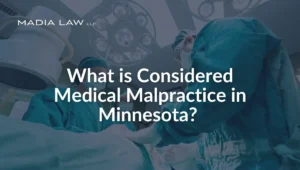
You trusted your doctor. You followed their advice, expected transparency, and hoped for a safe recovery. When that trust is broken, when something goes wrong and you’re left with unexpected injuries or long-term complications, it can feel overwhelming.
In Minnesota, not every bad outcome is considered malpractice. But when a healthcare provider fails to meet the standard of care and causes preventable harm, the law may be on your side.
Understanding what qualifies as medical malpractice, and what doesn’t, is the first step toward protecting your rights, pursuing justice, and making confident decisions about your next steps.
What Qualifies as Medical Malpractice Under the Law in Minnesota?
Not every medical error is malpractice. But if a provider fails to meet the standard of care and causes harm, it may cross the legal line. Minnesota law applies clear criteria to decide when a mistake becomes malpractice.
Legal Definition of Medical Malpractice in Minnesota
Under Minnesota law, medical malpractice is defined as a situation where a licensed healthcare provider, such as a doctor, nurse, or hospital, fails to provide care that meets the accepted medical standard. This standard refers to what a reasonably skilled and careful provider in the same field would have done under similar circumstances.
Crucially, it’s not enough that a treatment resulted in a poor outcome. For a valid malpractice claim, 2 things must be proven:
- The provider deviated from the standard of care, and
- That deviation directly caused harm, injury, or death that could have been avoided with proper care.
Whether it involves a surgical error, misdiagnosis, medication mistake, or failure to act, the key element is negligence, and its direct impact on your health.
Core Legal Elements of a Malpractice Claim
To bring a medical malpractice claim in Minnesota, you must establish 4 legal elements. These elements form the foundation of what is considered medical malpractice under state law:
- Duty of Care: There must be a clear provider-patient relationship, typically shown through medical records or billing history. This relationship creates a legal responsibility for the provider to deliver competent and appropriate care.
- Breach of Duty: The provider failed to meet the accepted standard of care. This could involve a misdiagnosis, surgical error, medication mistake, or neglect. Proving a breach often requires expert testimony from another qualified medical professional.
- Causation: You must show that the provider’s negligence directly caused your injury. It’s not enough that something went wrong, the error must be the actual reason for your harm, such as a delayed diagnosis leading to worsened outcomes.
- Damages: You need to demonstrate measurable harm. This can include physical injury, emotional distress, lost wages, medical expenses, or long-term disability, supported by medical records, employment documentation, or financial statements.
If even one of these elements is missing or cannot be proven, the claim may not meet Minnesota’s legal threshold for malpractice

Common Medical Errors That Can Lead to a Claim
Not every medical mistake counts as malpractice under Minnesota law. But if a preventable error happens because a healthcare provider failed to follow the accepted standard of care, and that mistake causes harm to the patient, it may qualify as medical malpractice.
Below are some of the most common types of medical negligence often seen in malpractice cases:
| Surgical Errors
Includes wrong-site surgery, performing an incorrect procedure, or leaving foreign objects (such as sponges or instruments) inside the patient’s body. These are often considered never events; errors that should never occur in competent medical practice. |
Diagnostic Failures
Misdiagnosis, delayed diagnosis, or failure to diagnose life-threatening conditions such as cancer, stroke, or sepsis. These errors can lead to disease progression, lost treatment opportunities, and worsened prognoses, forming a direct basis for establishing causation in a malpractice claim. |
Medication Mistake
Administering the wrong medication or dosage, overlooking known drug allergies, or prescribing medications that cause dangerous interactions. These errors may constitute breaches of the duty of care. |
| Failure to Monitor or Follow Up
Neglecting to review lab results, monitor a patient’s condition post-treatment, or issue proper discharge instructions. This omission of care can be just as legally actionable as an active error when it results in preventable injury or deterioration. |
Birth Injuries
Improper fetal monitoring, delayed C-sections, or negligent management of labor and delivery can cause permanent injury to the infant or mother. When these injuries are due to substandard care, they may support a claim for obstetric malpractice. |
For a legal consultation, call 612-349-2729
What Does Not Qualify as Medical Malpractice in Minnesota?
In Minnesota, if a healthcare provider followed accepted standards of care, even if the treatment led to complications or didn’t go as hoped, it usually doesn’t qualify as malpractice. Some medical procedures carry known risks, and if those risks occur despite proper care, they typically are not grounds for a legal claim.
Expected Complications and Disclosed Treatment Risks
Some procedures carry known risks, even when done properly. If those risks were explained beforehand, usually through the informed consent process, and you agreed to proceed, resulting complications do not qualify as malpractice. As long as the provider followed the standard of care, the law does not consider the outcome to be negligence.
Situations Where the Standard of Care Was Followed
Not all medical complications result from negligence. In some cases, a provider may follow the accepted standard of care, make appropriate decisions, and still face an unfortunate outcome. Medicine is not an exact science, and even the best care can involve risks. When a qualified provider acts as another reasonable professional would in the same situation, the law does not consider the result malpractice, even if the outcome is serious or unexpected.
Medical Harm Without Direct Causation From Negligence
In Minnesota, proving medical malpractice requires more than showing that harm occurred, it requires a direct link between the provider’s negligence and the injury suffered. If that connection can’t be clearly established, the claim cannot proceed.
For instance, if a nurse makes a documentation error but the patient still receives the correct treatment and experiences no negative effects, there is no legal basis for malpractice. The law focuses on whether the harm was specifically caused by negligent care, not simply whether it happened during medical treatment.
How to Know If You Have a Valid Medical Malpractice Case
It is not always clear whether a bad medical outcome was just unfortunate or the result of malpractice. You do not need to figure that out alone. An experienced medical malpractice attorney can review your records, assess what happened, and help determine if your case meets Minnesota’s legal standards for a valid claim.
Recognizing Red Flags in Real-Life Situations
If you are unsure whether your experience involved medical malpractice, these red flags may help you identify possible warning signs:
- Worsening Condition After Treatment: You developed new or unexpected symptoms after a routine procedure, especially if those risks were never explained to you by your health care provider.
- Conflicting Second Opinion: Another doctor says your diagnosis or care plan was delayed, incorrect, or missed a serious issue.
- Early Discharge Without Clear Instructions: You were sent home feeling unwell, with no clear follow-up plan, and later required emergency care.
- Blocked Access to Records or Answers: You’ve requested further information or medical records and received vague responses, delays, or outright refusals.
- Treatment Given Without Consent: You received a procedure or medication without your approval or a full explanation of the risks.
These signs do not guarantee malpractice, but they may suggest that the provider did not meet the required standard of care. If any of this sounds familiar, speak with an attorney to review your situation.
Comparing Your Case to Proven Malpractice Scenarios
Understanding whether your situation qualifies as medical malpractice often involves examining similar cases, particularly those where malpractice was confirmed or ruled out.
| Scenario | Outcome | Key Difference |
|---|---|---|
| A patient was misdiagnosed but received a second opinion in time and fully recovered. | No malpractice | There was no lasting harm, and the mistake was corrected quickly. |
| A patient was misdiagnosed, did not receive proper treatment, and developed permanent complications. | Malpractice | The provider’s mistake directly caused serious harm. |
Even with similar errors, a malpractice case requires a breached duty, proven harm, and a direct link to negligence. Without all three, the case is unlikely to meet the legal standard.
Click to contact our personal injury lawyers today
Real Examples of What Is and Is Not Medical Malpractice
Real case outcomes show how Minnesota law draws the line between unavoidable complications and provider negligence. These examples illustrate how similar situations can result in different legal outcomes, depending on whether the provider met the required standard of care.
Case Example 1: Stroke Misdiagnosis Resulting in Permanent HarmA middle-aged patient came to a Minnesota ER with slurred speech, facial drooping, and one-sided weakness, clear signs of a stroke. The health care provider failed to order brain imaging and discharged the patient with a diagnosis of fatigue. Hours later, the patient suffered a major stroke and was left permanently disabled. This qualifies as medical malpractice. The provider breached diagnostic standards, and that mistake directly caused preventable, long-term harm. |
Case Example 2: Adverse Reaction Covered by ConsentA patient had a severe allergic reaction to a prescribed medication and was briefly hospitalized. But the medical care provider had disclosed this risk during the informed consent process and followed all standard protocols when administering the drug. This does not qualify as malpractice. The reaction was a known and accepted risk, not the result of negligent care. |
Case Example 3: Wrong-Site Surgery With Lasting ImpactA patient was scheduled for surgery on the left knee, but the surgeon operated on the right knee instead. This mistake caused lasting damage and left the original condition untreated. This is a clear case of medical malpractice. The surgeon violated standard surgical safety protocols, resulting in direct, permanent harm. All 4 legal elements—duty, breach, causation, and damages—are present. |
Complete a Case Evaluation form now
What to Do If You Suspect You’re a Victim of Malpractice in Minnesota
If something about your medical care feels wrong, trust your instincts. Many valid malpractice claims begin with a single question: Was this preventable?
What you do next matters. The actions you take now can help preserve evidence, clarify your rights, and protect your ability to pursue a claim under Minnesota law.
Request Your Full Medical Records Immediately
If you believe your care may have involved malpractice, request a full copy of your medical records. Include imaging, test results, prescriptions, doctors’ notes, and discharge summaries. This is your legal right under both Minnesota and federal law.
Make the request in writing, and do it as soon as possible. The longer you wait, the harder it may be to locate key records or fill gaps in your timeline of care.
Keep a Journal of Symptoms, Conversations, and Documents
To support a potential malpractice claim, begin recording everything related to your care. Track symptoms as they appear, note conversations with your care providers, and document instructions, prescriptions, or follow-up plans.
Date each entry. Include names, roles, and a summary of what was said or done. Even small notes, like when the pain started or what a doctor recommended, can help build a clear and reliable timeline.
Get a Second Medical Opinion from an Unrelated Medical Provider
A second opinion from a doctor outside your original care team can help uncover mistakes or missed diagnoses. An independent provider may recognize deviations from the standard of care that were not addressed initially.
When getting a second opinion:
- Choose a provider with no prior connection to the original team.
- Bring copies of all relevant medical records and test results.
- Ask for a written report that explains the diagnosis and recommended treatment.
- Share your concerns about past care and ask how they would have handled it differently.
Contact a Minnesota Medical Malpractice Attorney
You do not need a full case file to speak with a lawyer. A Minnesota medical malpractice attorney can review your situation, explain your legal options, and assess whether your experience meets the standards for a claim.
Before your consultation, try to gather:
- A brief timeline of your care and symptoms.
- Any medical records you have already requested.
- Notes from conversations with your providers.
- Journal entries that document your treatment and outcomes.
- Specific questions about your legal rights or next steps.
Even if you are not sure malpractice occurred, an attorney can help determine whether the facts support a claim under Minnesota law.
Malpractice vs. Negligence: What’s the Difference?
Negligence refers to any careless act by a medical provider. Malpractice goes further; it involves negligent care that causes actual harm.
Here are the differences:
| Aspect | Medical Negligence | Medical Malpractice |
|---|---|---|
| Definition | A provider makes a mistake or oversight during care. | A provider’s mistake leads to harm and meets the legal test for malpractice. |
| Standard of Care | The provider deviates from accepted medical practice. | The provider breaches the standard in a way that causes injury. |
| Harm Involved | No significant harm or only minor discomfort. | Significant physical, emotional, or financial harm. |
| Legal Action | Usually not enough for a lawsuit. | This can lead to a malpractice claim under Minnesota malpractice law. |
| Proof Required | Must show the provider acted unreasonably. | Must show breach, causation, and measurable damages. |

How Medical Malpractice Affects Families and Finances
When a patient is harmed by medical malpractice, the impact often reaches far beyond the individual. Families take on new responsibilities, miss work, and absorb emotional and financial stress that can last for years.
Emotional Toll and Loss of Trust
Malpractice can damage more than physical health. It often breaks the trust that families place in doctors, hospitals, and the medical system. Survivors may experience anxiety, depression, or trauma. Loved ones may struggle with guilt, grief, or fear of future care. These emotional effects can delay recovery and strain relationships.
Long-Term Financial Strain and Care Costs
The financial consequences of malpractice are often severe. Families may face ongoing medical bills, lost wages, home modifications, and long-term care costs. If the injured person can not return to work, the loss of income adds more pressure. Over time, savings may be depleted, and debt can grow.
What Makes Medical Malpractice Hard to Prove Without a Lawyer?
Proving medical malpractice in Minnesota requires more than showing a your care provider made a mistake. You must prove that the error breached the standard of care and directly caused measurable harm. Without legal guidance, many claims fall short due to missing records, expert requirements, or missed deadlines.
Why Some Legitimate Cases Get Overlooked
Even strong medical malpractice cases can be dismissed without the right documentation or legal framing. Common issues that prevent valid cases from moving forward include:
- Missing or incomplete medical records: Without full documentation, it is difficult to prove what happened or when care deviated from the standard.
- Plausible provider defenses: Doctors may defend poor outcomes as expected risks, even when preventable harm occurred.
- Insurance denials: Claims may be rejected early, often without a full review, in the hope that the patient will not challenge the decision.
- Delays by the patient: Waiting too long to seek legal advice can lead to lost records, missed deadlines, or expired filing windows.
Legal Complexities Laypersons Often Miss
Even valid malpractice claims can be dismissed due to simple legal mistakes. Without an attorney, it is easy to overlook critical rules that govern how and when to file.
Common legal pitfalls include:
- Missing Minnesota’s statute of limitations, which can bar your case entirely if you file too late.
- Suing the wrong party, such as naming the hospital when only an individual provider is liable (or vice versa).
- Failing to file a required certification of expert review, which Minnesota law mandates early in the case to show that a qualified medical expert supports your claim.
Why Medical Errors Are More Common Than You Think
Medical mistakes happen more often than people expect, not because patients fail to follow instructions but because the system often fails them. Staffing shortages rushed care, and communication failures can lead to errors that cause serious and avoidable harm.
Burnout and Understaffing in Minnesota Hospitals
Many Minnesota hospitals are short-staffed. Long shifts, high patient loads, and limited nursing support create conditions that can lead to even experienced providers making preventable mistakes. Fatigue and time pressure reduce the quality of care, not due to a lack of skill but rather due to a lack of resources.
Communication Breakdowns Between Medical Teams
Miscommunication between doctors, nurses, and specialists is one of the top causes of medical errors. Incomplete charting missed handoffs, or failure to update a treatment plan can lead to serious injury. When teams do not share key details, patients suffer the consequences.
When Doctors Dismiss Patient Concerns Too Quickly
Patients often recognize when something feels wrong. But when providers rush visits or ignore symptoms, early warning signs can be missed. This delay in care may lead to preventable complications, especially when symptoms are minimized, dismissed, or misattributed to other causes.
How a Lawyer Proves Medical Malpractice in Minnesota
Proving medical malpractice in Minnesota means showing that a provider’s actions violated the standard of care and caused real harm. At Madia Law LLC, we build each claim by analyzing records, consulting medical experts, and meeting all procedural deadlines.
Securing Medical Records and Reviewing the Timeline
A malpractice claim begins with obtaining comprehensive medical records, including progress notes, diagnostic tests, imaging studies, discharge summaries, and treatment plans. These records help reconstruct a precise timeline of events. Reviewing them early allows your attorney to identify where the standard of care may have been breached and to preserve evidence that may be lost over time.
Using Expert Witnesses to Validate Negligence
Minnesota law requires medical malpractice claims to be supported by expert review. Attorneys work with licensed specialists who assess whether the provider’s actions deviated from what a reasonably competent professional would have done. Expert testimony explains complex medical issues and confirms that the provider’s conduct fell below the required standard, causing harm. Without specialist support, courts may dismiss the claim early in the process.

What Compensation Can You Recover in a Malpractice Case in Minnesota?
When pursuing a medical malpractice claim in Minnesota, compensation includes both economic losses, like medical bills and lost income, and non-economic damages, such as pain, suffering, and emotional distress. Understanding these categories is key to documenting your losses and maximizing recovery.
Economic Damages: Medical Bills, Lost Wages, Future Care
Economic damages in a Minnesota medical malpractice case compensate for the financial losses caused by negligent medical care. These damages are based on documented costs and projected future needs.
Examples include:
- Medical expenses: Costs of hospitalization, surgery, medication, testing, and follow-up treatment.
- Lost wages: Income missed during recovery due to your injury.
- Reduced earning capacity: Future income loss if you cannot return to your previous job or career.
- Rehabilitation: Ongoing therapy, mobility aids, and physical assistance.
- Home or vehicle modifications: Accessibility changes required due to disability.
- Long-term or in-home care: When medical harm prevents independent living.
These financial losses can be proven through billing records, tax returns, employment statements, and care plans.
Non-Economic Damages: Pain, Suffering, Loss of Enjoyment
Non-economic damages compensate for the personal impact of medical malpractice that cannot be measured in any number of amount. These losses affect your emotional well-being, relationships, and daily functioning.
Common examples include:
- Chronic physical pain: Ongoing discomfort or physical limitations after negligent treatment.
- Emotional distress: Anxiety, depression, or trauma caused by the injury or treatment experience.
- Loss of enjoyment of life: Inability to engage in hobbies, activities, or routines you once valued.
- Strained personal relationships: Marital stress, family burden, or social withdrawal.
- Reduced independence: Loss of ability to care for yourself or participate in everyday life.
Though harder to calculate, these damages are just as real as financial costs. Courts often rely on testimony, journals, and psychological evaluations to assess their impact.
Punitive Damages for Reckless Conduct (Rare Cases)
Punitive damages are rarely awarded in Minnesota medical malpractice cases. These damages do not compensate the patient; they punish healthcare providers for reckless or intentional wrongdoing and aim to deter similar conduct.
Punitive damages may apply in cases involving:
- A provider operating under the influence of drugs or alcohol.
- Falsifying medical records to cover up mistakes.
- Knowingly ignoring life-threatening symptoms.
- Intentional harm or grossly unethical behavior.
Minnesota courts reserve the right to award punitive damages for conduct that exceeds negligence. When awarded, they signal the court’s intent to hold providers accountable for serious violations of patient safety and public trust.
Why Choose Madia Law LLC for a Malpractice Case in Minnesota?
Choosing the right legal team after medical negligence is deeply personal. Families across Minnesota and Minneapolis turn to Madia Law LLC because of our focused experience, honest case evaluations, and commitment to holding healthcare providers accountable.
Proven Experience in Complex Medical Negligence Cases
Our attorneys have handled complex malpractice claims for over a decade. This includes cases involving surgical mistakes, birth injuries, misdiagnoses, and wrongful death. We understand how to investigate records, consult qualified experts, and meet Minnesota’s legal requirements for malpractice claims.
Strategic Advocacy and Personalized Legal Care
At Madia Law LLC, we handle every case with care, strategy, and personal attention. From day one, we prepare your case with a clear plan built on strong evidence and expert support. You will work directly with an experienced attorney who keeps you informed, answers your questions, and guides you through each step of the process.
Record of Results in Medical Malpractice Claims
Madia Law LLC has recovered millions for patients harmed by medical negligence. We secured $2.05 million for a client whose cancer was misdiagnosed, delaying life-saving treatment. In another case, we secured $1.4 million after a surgical error resulted in permanent disability. These outcomes reflect our ability to build strong, evidence-backed claims that hold providers accountable.
FAQs About Medical Malpractice
Can I sue for medical malpractice without a lawyer?
Yes, you can sue for medical malpractice without a lawyer, but it is extremely difficult to succeed without legal representation. These cases require expert medical opinions, detailed records, and strict procedural steps. Most self-filed claims are dismissed before reaching trial.
How long do I have to file a malpractice claim in Minnesota?
In Minnesota, you generally have 4 years from the date the injury was discovered or reasonably should have been to file a medical malpractice claim.
What is the average payout in a medical malpractice case?
There is no fixed average payout for medical malpractice cases in Minnesota. Settlements depend on injury severity, lost income, and future care needs. Serious cases may reach hundreds of thousands or more.
Can I sue a nurse or hospital, not just the doctor?
Yes, you can sue a nurse, hospital, or other healthcare providers, not just the doctor. Liability may apply to anyone involved in the negligent care that caused your injury.
Speak With a Minnesota Malpractice Attorney

Medical harm can leave you overwhelmed and unsure of where to turn. But time matters. Critical evidence can be lost, deadlines can pass, and answers can slip away.
Call 612-349-2729 or complete a Case Evaluation form

